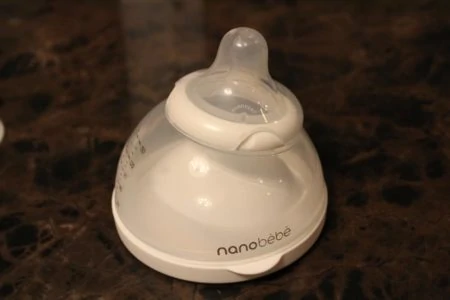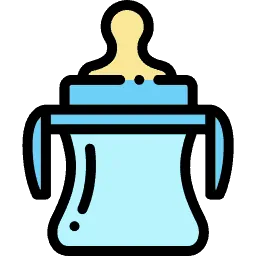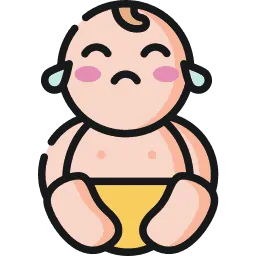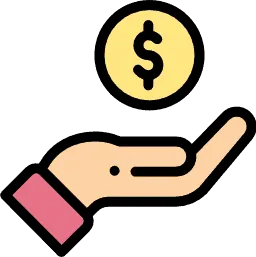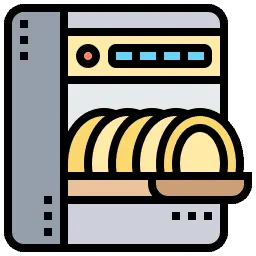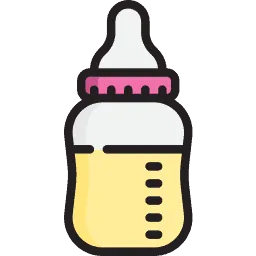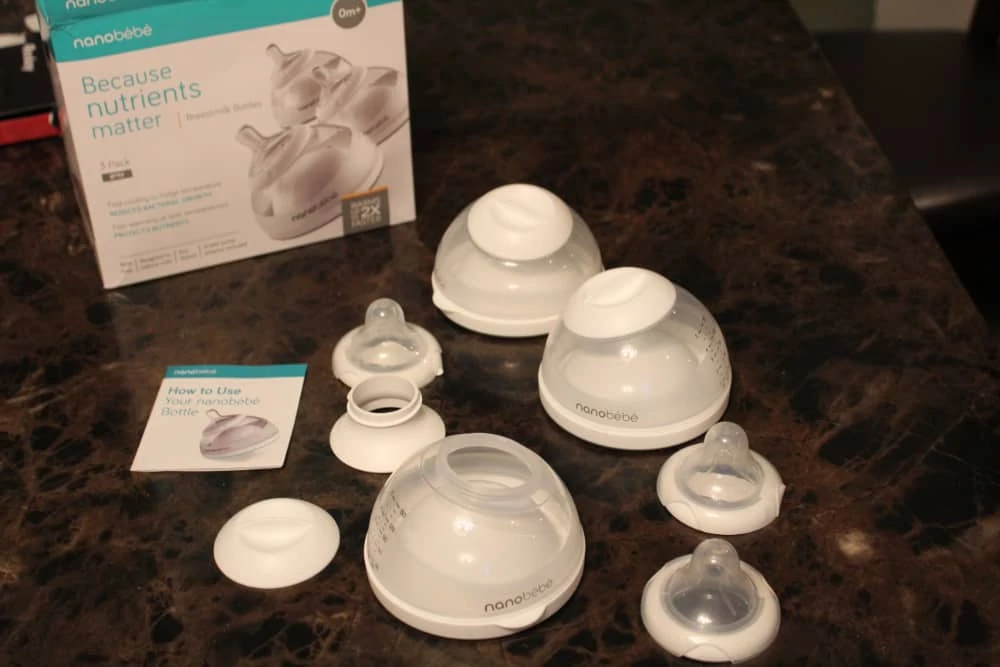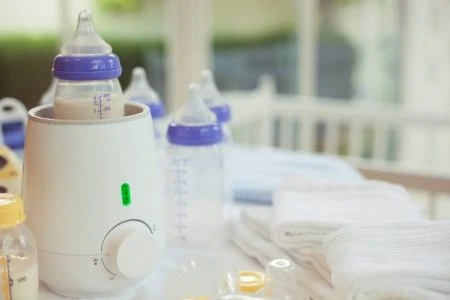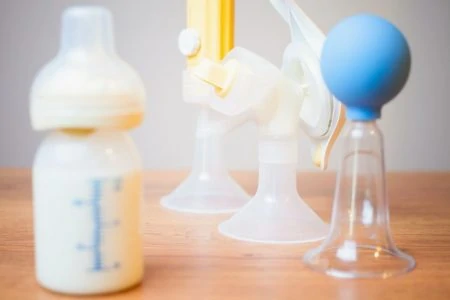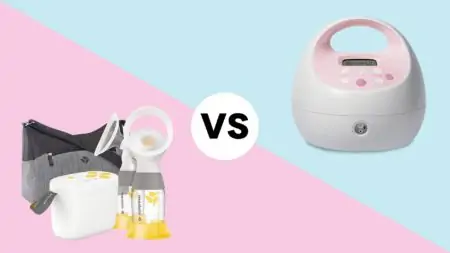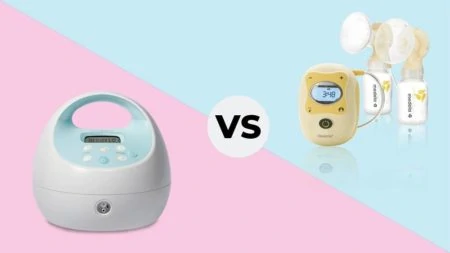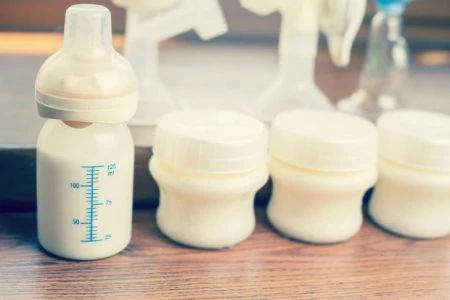I planned to breastfeed my baby exclusively for the first year, exactly as my doctor and lactation consultant suggested. But then I heard the nightmarish tales of babies refusing to breastfeed after trying bottles. I was worried because I definitely didn’t want my baby to stop nursing entirely.
“Nipple confusion” sounded funny to me at first. Then I considered how stressful it would be if it happened to us. When my little one started feeding erratically after I introduced her first bottle, I panicked and wondered if I had ruined a good thing. Now I know that I should have paid a little more attention to the specific bottle I gave her.
What are the best bottles for breastfed babies, and is there anything you can use to stop that breast or bottle confusion from developing? Let’s find out.
- Withstand heating and squeezing
- Great for vacations
- Close to breastfeeding experience
- Uniquely stable non-tipping base
- Helps with reflux and colic
- Chunky, tactile shape
- Realistic nipple look & feel
- Easy to assemble and clean
- Helps fight colic
- Easy to clean or fill
- Compatible with any Avent nipple
- Anti-colic features
- Great choice for picky babies
- Natural feeling nipple
- Collapse-resistant nipple
- Realistic nipple
- Great for babies that refused bottle
- High quality and non-toxic materials
What Your Breastfed Baby Wants in a Bottle
Buying bottles for breastfed babies requires some strategy; you can’t just grab the cheapest option and call it good. You don’t want to risk turning your baby off breastfeeding forever because they picked up bad habits from a poorly designed nipple.
Put yourself in the mindset of an infant. Consider the following when choosing the perfect feeding substitute so they won’t turn their nose up the next time you offer the breast.
What Mom Wants in a Bottle
In some ways, it is easier to go shopping for a new house than it is to pick out a baby bottle. At least with house hunting, you know what you like. You have lived in a home your whole life, so you understand your basic needs.
Bottle shopping is different. This is a completely foreign task if you are a new parent, and you likely don’t have time or money to waste on trial and error.
Start by narrowing your search to bottles that meet the standards your breastfed baby would ask for if they could talk, then look at the criteria that matter to you.
Product Reviews
We tested features, flow rates, and latch acceptance to find the top bottles for breastfed babies:
Comotomo Natural-Feel Baby Bottles
Best Travel Bottle for Breastfed Babies
It doesn’t get much simpler than Comotomo. These are incredibly easy to assemble, and the ultra-wide neck means you can stick your whole hand inside to clean it, no bottle brush required.
These are widely considered the gold standard for transitioning from breast to bottle. The nipples are large and soft, mimicking the natural breast mound.
In a dramatic twist from standard hard plastic bottles, the base itself is soft silicone. This allows your baby to grab and squish the bottle while feeding, replicating the tactile experience of breastfeeding.
You can microwave them, boil them, or toss them in the dishwasher. If you use a baby bottle sterilizer, they fit easily. The medical-grade silicone won’t warp or melt under high heat.
Both the nipple and the base utilize dual anti-colic vents to keep air circulation moving without leaks.
Pros
- Highly durable material withstands heating and squeezing.
- Wide mouth requires no special brushes for cleaning.
- Soft, skin-like texture helps avoid bottle rejection.
Cons
- Higher price point than standard plastic bottles.
- The rounded shape tips over easily on uneven surfaces.
Our Ratings
NUK Smooth Flow Bottles
Best Budget Breastfeeding Bottle
This 10-ounce bottle combines solid performance with an affordable price tag. Because of the larger capacity, you won’t have to buy new sizes as your baby’s appetite grows past the newborn stage.
It features a unique Y-cut nipple design that gives a more realistic feel. The baby controls the flow based on their suction strength, much like breastfeeding. The wide silicone nipple stretches with your baby’s palate movement, which helps maintain a continuous latch.
To help cut down on spit-up, these use a one-piece anti-colic air vent. Because the system is built directly into the nipple, you don’t have to fuss with cleaning extra tubes or valves.
A standout feature is the SafeTemp indicator, which changes color if the milk is too hot. The bottle also has an ergonomic shape that is comfortable for parents to hold during long feeds.
Pros
- Wallet-friendly price for a 3-pack.
- Integrated anti-colic vent means fewer parts to wash.
- SafeTemp indicator prevents accidental burns.
- Milk only flows when the baby suckles, preventing spills.
Cons
- The protective cap can be difficult to remove one-handed.
- Flow might be slightly fast for very young preemies.
Our Ratings
Nanobebe Baby Breastfeeding Bottles
Most Innovative Breastfeeding Bottle
Nanobebe breaks the mold with a design that looks like a breast. The shape consists of a hollowed dome, similar to an upturned bowl. The nipple is angled, and the unique geometry allows your baby to hold the bottle easily at a younger age.
If you are concerned about preserving the nutritional content of your pumped milk, this is your bottle. The concave surface area allows milk to heat up and cool down two times faster than standard bottles. This rapid cooling reduces bacterial growth, while rapid (gentle) warming prevents hot spots that damage nutrients.
You can pump directly into these bottles using an adapter, and they stack perfectly in the fridge to save space.
Pros
- Wide, stable base prevents tipping.
- Concave shape protects breast milk nutrients during warming.
- Easy for small hands to grip for self-feeding.
Cons
- The wide shape takes up more horizontal space in diaper bags.
Our Ratings
Mimijumi Get Going Bottle Kit
Best Plastic Breastfeeding Bottle
Your baby should love the appearance of this bottle set. The large, flesh-colored nipple is surprisingly boob-like, looking and feeling like the real deal. It is so realistic that your baby might do a double-take when they see it.
The set comes with four bottles: two in the “Very Hungry” larger size and two in the “Not So Hungry” smaller size. There are hardly any parts to fuss with, making assembly a breeze. The nipple screws directly onto the bottle base, eliminating the need for a separate ring.
The slow-flow nipples and spiraled interior design help ward off fussiness caused by colic. They are BPA-free, and the super wide necks mean you can clean them in seconds with a standard sponge.
Pros
- Hyper-realistic nipple color and texture.
- Simple two-piece assembly.
- Integrated venting helps fight colic.
Cons
- Significantly more expensive than standard brands.
- The nipples can be tricky to screw on tight enough to prevent leaks.
Our Ratings
Munchkin Latch Newborn Bottles
Best Anti-Colic Breastfeeding Bottle
This set offers excellent value. You get three 4-ounce bottles with two slow-flow nipples, one stage-two medium-flow nipple, and three sealing discs. Pump adapters (sold separately) allow you to connect these directly to leading breast pumps.
These bottles are a top choice for preventing colic because of the “accordion” style nipple base. This allows the nipple to stretch and flex like a breast, maintaining the latch even if the baby moves their head.
The anti-colic valve at the bottom of the bottle ensures air bubbles don’t mix with the milk. Because the air enters from the bottom, it bypasses the liquid entirely.
Made from BPA-free plastic and silicone, the set is top-rack dishwasher safe.
Pros
- The flexible nipple maintains the latch as baby moves.
- Bottom valve is highly effective at reducing gas.
- Includes sealing discs for milk storage.
Cons
- The bottom valve requires careful cleaning to prevent mold.
- Must be assembled precisely to avoid leaks.
Our Ratings
Philips Avent Natural Glass Baby Bottles
Best Glass Bottle for Breastfed Babies
Philips Avent is a heavyweight in the baby world, and these glass bottles are a favorite for eco-conscious parents.
They come in a three-pack, holding 4 ounces each. What makes them shine for breastfed babies is the wide, breast-shaped nipple with unique “petals” inside that increase softness and flexibility without collapse.
The bottles feature an advanced anti-colic twin valve system designed to vent air into the bottle and away from your baby’s tummy. Since the venting is in the nipple rim, there are no extra tubes to clean.
Philips uses premium borosilicate glass, which is thermal shock resistant. You can move it from the fridge to a baby bottle warmer without fear of cracking.
Pros
- Borosilicate glass is pure, recyclable, and chemical-free.
- Compatible with the entire Avent Natural range.
- Wide neck makes filling and cleaning spill-free.
Cons
- Glass is heavier than plastic, which is harder for babies to hold.
- Breakable if dropped on hard tile floors.
Our Ratings
Lansinoh mOmma NaturalWave Bottle
Short Nipple Choice
These Lansinoh bottles have a cult following among parents of “bottle refusers.” The nipple shape is distinct: matte, thick, and gradually tapered.
The “NaturalWave” design is clinically proven to reduce nipple confusion. It encourages the same wave-like tongue movement babies use at the breast, which is vital for oral development.
Beyond the nipple, the bottle is made of sturdy, BPA-free plastic with a wide neck. Many moms love that this bottle fits perfectly with Lansinoh pumps and is surprisingly compatible with nipples from several other brands.
Pros
- High success rate with picky babies who refuse other bottles.
- Matte texture prevents the nipple from slipping.
- Nipple is collapse-resistant, preventing frustration.
Cons
- Standard nipple flow may be too fast for newborns (buy slow-flow separately).
- The soft silicone can crack if bitten by teething babies.
Our Ratings
Tommee Tippee Closer Nature Bottles
Helps for Natural Latch
Tommee Tippee bottles have a distinctive curvy shape that fits perfectly in your hand. Experts designed the nipple to flex like a mom’s breast, featuring a super-wide base and a soft silicone tip. The company claims 92% of babies accept this nipple within the first three attempts.
The bottle features a sensitive Easi-Vent valve on the nipple to reduce excessive airflow, ensuring your baby swallows milk, not air.
The compact shape allows you to hold the baby closer to you during feeds, enhancing that bonding moment. You can choose from 5, 9, or 11-ounce sizes depending on how hungry your little one is.
Pros
- Highly realistic flex and stretch for an easy latch.
- Ergonomic shape is comfortable for parents to hold.
- BPA and phthalate-free materials.
Cons
- Measurement markings can wear off after repeated washing.
- Nipple collapses if the vent slit gets stuck closed (pinch to open).
Our Ratings
Dr. Brown's Wide Neck Bottle
Best Wide Neck Breastfeeding Bottle
Dr. Brown’s bottles are the industry leader for colic issues. This wide-neck version combines their famous vent system with a more breast-like nipple shape.
The internal green vent system channels air away from the milk, mimicking a vacuum-free breastfeeding experience. This drastically reduces colic, spit-up, and burping. As the baby grows and their digestion matures, you can actually remove the vent and use it as a standard bottle.
If you have a baby showing signs of nipple confusion who also suffers from painful gas, this bottle tackles both problems simultaneously.
Pros
- Superior venting system eliminates air bubbles effectively.
- Wide neck is easier to clean than the “standard” narrow Dr. Brown’s.
- Vent system can be removed as the baby grows.
Cons
- Multiple parts (vent, reservoir, disk) make cleaning tedious.
- Known to leak if overfilled or heated with the collar on tight.
Our Ratings
Playtex Bottle with Disposable Liners
A Breeze to Clean Up
These Playtex bottles utilize a clever disposable liner system: simply drop a liner into the frame, fill it with milk, and recycle the liner when done.
The liners aren’t just convenient; they are excellent for colic. As your baby drinks, the soft liner collapses, ensuring no vacuum forms and no air enters the tummy. The liners come pre-sterilized, making this a fantastic option for travel or quick feeds.
The bottle frame hinges at the neck, allowing you to angle the bottle for a comfortable feeding position without tipping the baby backward.
Pros
- Pre-sterilized liners ensure hygiene on the go.
- Collapsing bag action naturally prevents air intake.
- Minimal washing required (only the nipple and ring).
Cons
- Ongoing cost of buying disposable liners.
- You must squeeze the air out of the liner manually before feeding.
Our Ratings
Tips for Buying Bottles
Once you have an idea of what type of bottle you want, go through this checklist to ensure you aren’t sabotaging your success by forgetting something crucial.
To avoid making a rookie mistake, follow these tips when buying that first bottle:
- Don’t buy in bulk: If you buy 20 bottles only to find your baby hates the nipple shape, you will be sorry. Instead, pick three potential candidates, buy one of each, and test them before making a full investment.
- Think about the future: Those cute 4-ounce bottles are perfect for a newborn. But that newborn will grow quickly, and soon they will be guzzling 6 or 8 ounces (3). Consider buying the larger size immediately; you can just fill them halfway now and save money later.
- Check pump compatibility: If you buy bottles that screw directly onto your breast pump, you save yourself the hassle of transferring milk (and washing an extra container).
- Refresh for Baby #2: We know it hurts to spend money, but if you have old plastic bottles from your first child, they may be scratched or degraded. Scratches can harbor bacteria, so it is safer to buy new nipples and bottles.
When Do I Introduce Bottles to My Breastfed Baby?
There is no telling how your baby will react to the switch. Some babies swap between breast and bottle easily, while others get hooked on the easy flow of a bottle and refuse the breast later.
The Sweet Spot
Beyond that window, your timing depends on your lifestyle:
- If you are with your baby 24/7 and are comfortable nursing in public, you can delay bottle feeding indefinitely.
- If you plan to return to work, start practicing with a bottle at least two weeks before your start date to reduce stress.
- If you are suffering from cracked nipples or mastitis, introducing a bottle sooner can give your body a chance to heal.
When in doubt, consult a lactation consultant. They can guide you on the timing to ensure you protect your milk supply.
Tips for Bottle-Feeding a Breastfed Baby
As a mom, you know that you can’t force a baby to do anything they don’t want to do. Slow and steady wins this race. A bottle introduced in a low-stress environment is more likely to be accepted. Relax, you’ve got this!
Try these tricks to get your baby to accept the new hardware:
- Timing is key: Don’t try this when the baby is starving and screaming. Offer the bottle when they are calm and slightly hungry, perhaps an hour after a nursing session.
- Start slow: Always use the slowest flow nipple (usually labeled “Newborn” or “0”) to mimic the effort of breastfeeding.
- Outsource the job: Babies can smell your milk. If you try to give the bottle, they might just root for your chest. Have your partner or a grandparent give the first few bottles while you leave the room.
- Switch it up: Try different positions. Facing away from the feeder (looking out at the room) sometimes works better than the cuddling position they associate with nursing.
- Warm it up: Breast milk comes out at body temperature. Run the bottle nipple under warm water or warm the milk to make it feel familiar.
- Bait and switch: Put some breast milk on the bottle nipple to entice them to latch.
What Is Paced Feeding?
When you eat dinner, you probably don’t inhale your food without taking a breath. You pause, chew, and chat. Natural breastfeeding follows a similar pattern of suck, swallow, breathe, and pause.
Standard bottle feeding often forces the baby to gulp continuously to keep up with the flow. This can lead to overeating and “nipple preference” because the bottle is easier than the breast.
Mimic The Breast
Here is how to do it:
- Sit upright: Hold the baby more upright than reclined.
- Keep it horizontal: Hold the bottle flat (horizontal) rather than tipped straight up. This prevents gravity from pushing milk into the baby’s mouth; they have to suck to get it.
- Take breaks: Every 20-30 seconds, tip the bottle down to stop the flow (keeping the nipple in the mouth) or remove it gently to let the baby breathe and check in with their hunger cues.
- Switch sides: Swap arms halfway through the feed, just like you would switch breasts. This stimulates the baby’s brain and eye development.
Paced feeding prevents “flow confusion” and ensures your baby doesn’t begin to prefer the bottle simply because it delivers food faster.
